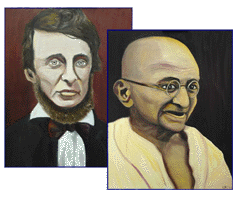"The whole aim of practical politics is to keep the populace alarmed (and hence clamorous to be led to safety) by menacing it with an endless series of hobgoblins, all of them imaginary." ~ H.L. Mencken
Why the Split Between Non-Violent and Violent Resistance?
Column by Paul Bonneau.
Exclusive to STR
Following a comment from the editor, it occurred to me to take a look at the split between those who advocate nonviolent resistance to tyranny, and those who would not thus limit themselves. Is it actually necessary for this split to exist?
I should first say, that anyone who has a favorite online source that addresses this issue, should note it in the comments. I will be interested to read it, if it is reasoned, honest, and avoids the use of logical fallacies.
I should also say that in this article, I am not talking about state action (e.g., use of standing armies) when I refer to “resistance to tyranny.” However, militia action may be included in this term, particularly that not controlled by government. Of course we do have to make a distinction between offensive and defensive violence. Only defense can be considered “resistance to tyranny.” One first has to be tyrannized, and thus automatically on the defense, in order for there to be something to resist.
I have not found much about this question of a split between violent and nonviolent tactics, but what I have read so far can be illustrated by a few examples.
In the "A Force More Powerful” FAQ, this statement is made (my emphasis):
Q. How is nonviolent conflict different from "nonviolence" or passive resistance?
A. Most of those who have used nonviolent action have not primarily been motivated by a desire to be nonviolent or to make peace. They have wanted to fight for their rights or interests, but by means other than guns or bombs--either because they have seen that violence had been ineffectual or because they had no violent force at their disposal.
Note, the emphasized passage is just a reporting of someone’s opinion, with no proof that I can find anywhere on the site. Further on:
Q: Is the anti-globalization movement that took to the streets of Seattle, Goteborg and Genoa likely to achieve its goals?
A: Not unless it unites behind a few clear goals that are related to the everyday concerns of people whose support it needs, and not until it mobilizes a broader cross-section of the societies whose governments underwrite the global organizations it opposes. But to do those things, it first has to disassociate itself unambiguously from the violent fringe that its street demonstrations attract. Nothing weakens a nonviolent movement more than the sporadic use of violence by people on its side of the barriers, because that discourages ordinary civilians from joining the ranks, and distracts the media and the public from the injustice or other grievances that the movement wants corrected.
Of course this is advocating against the random trashing of property of innocent individuals that occurred in these protests (often by provocateurs)--something that would be outside the norm for people engaging in violent (defensive) resistance as well.
So, this website has an unsatisfactory treatment of the incompatibility of violent and nonviolent resistance.
The Wikipedia article on nonviolent resistance makes this claim: “From 1966 to 1999 nonviolent civic resistance has played a critical role in 50 of 67 transitions from authoritarianism.” While this sounds impressive, even if true, it does not say that violent resistance did not also play a part, perhaps a critical part, in these transitions. The citation for this statement is the aforementioned website, which did not back that statement up that I could tell (apparent link rot).
The Wikipedia article on nonviolence makes this claim: “Proponents of nonviolence reason that the actions taken in the present inevitably re-shape the social order in like form. They would argue, for instance, that it is fundamentally irrational to use violence to achieve a peaceful society.” This is of course mere assertion, and contrary to ordinary experience and history. For example, the American Revolution achieved a relatively peaceful society for a while; at any rate, for a duration as long as that claimed for societies brought about by nonviolent means. India has a government as violent as most others. Also, at the more personal level, pulling out a gun and scaring off a thief achieves peace for the intended victim.
So, at least so far, I have seen little to explain why nonviolent action is necessarily incompatible with defensive violence. What needs to be (and apparently cannot be) demonstrated, is there is a correlation between the use only of nonviolent tactics and a subsequent, sustainable nonviolent (anarchist) society; and that the injection into that equation of any significant violence defeats that end.
Now, some common sense has to be applied. Nonviolent tactics are predominantly collective ones; and the larger the movement, the better. It does make sense to tell participants of demonstrations to bring no firearms, and to be nonviolent, and to widely publicize this; so that when someone starts shooting, or overturns cars and burns them, they can be shown to be provocateurs. But does that mean a participant of such a demonstration must give up self-defense entirely? If he goes home from his nonviolent demonstration, and a group of NKVD-like thugs later show up at his door to arrest him, must he submit and disappear into the Gulag? No. He may morally choose to fight.
Defense is often an individual tactic, unlike nonviolent action; or it is done in very small groups. One does not have to forever sacrifice oneself for the good of collective, nonviolent action; although during the nonviolent action or event, the possibility of sacrifice is often implied. The collective action is not besmirched if one uses defensive action where it makes sense. Indeed, Martin Luther King and some of his nonviolent associates were armed.
It appears that historically, both nonviolent and violent action have managed only the transition from one statist regime to another. Neither have brought a transition to a government-free (that is, state violence-free) society.
The “A Force More Powerful” site shows 198 methods for non-violent action. I see not a single one that could not also be used by people who are not pacifists and not subscribed to nonviolent action. Many frequently are used by such people.
Lew Rockwell emphasizes nonviolent action on his website, yet also carries gun and defense articles.
People who consider themselves nonviolent may nevertheless own weapons, and (in my opinion) should own them, for individual and family defense, and for making useful connections with people less inclined to nonviolence.
People who don’t consider themselves nonviolent may nevertheless use nonviolent tactics, and (in my opinion) should use them as much as possible, and seek connections with people inclined to nonviolence.
I see no reason for this split. The split is and should be between aggression and defense, not between defense and nonviolence.








 Reprint Rights
Reprint Rights
Comments
In the right hand column of STR I see depictions of two practitioners of non-violent resistance - Thoreau and Gandhi. Gandhi I believe was a moral absolutist on non-violence holding that violence was wrong even in self defense. Thoreau did not preach violence that I'm aware of, but on the other hand he was a fan of Captain John Brown.
I take the view that violence can be justified, but only when practical. I hear a lot of loose stupid talk about violence against the state that won't come to any good. I greatly prefer Gandhi to McVeigh even though I am more fundamentally at philosophical odds with the former than the latter.
Woops, I goofed, pasting this comment on the wrong article.